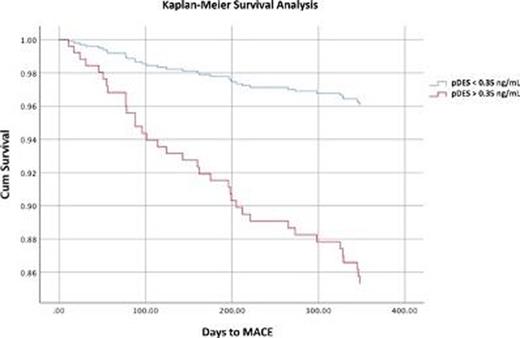-
PDF
- Split View
-
Views
-
Cite
Cite
Z Iskandar, S Patel, T Lancefield, M Freeman, M Horrigan, O Farouque, J.T.J Huang, C.C Lang, L.M Burrell, A.M Choy, Plasma desmosine, a biomarker of elastin degradation, predicts outcomes in coronary artery disease, European Heart Journal, Volume 41, Issue Supplement_2, November 2020, ehaa946.1351, https://doi.org/10.1093/ehjci/ehaa946.1351
Close - Share Icon Share
Abstract
Recent evidence from animal studies suggests that elastin degradation accelerates atherosclerosis and increases risk of plaque rupture and subsequent myocardial infarction and stroke. Desmosine is an elastin-specific degradation product. We analysed the prognostic value of plasma desmosine (pDES) in a cohort of patients with coronary artery disease (CAD).
Patients with CAD (n=400) undergoing elective coronary angiography were prospectively recruited over 3 years and had bloods drawn for analysis of pDES using a validated stable isotope dilution liquid chromatography-tandem mass spectrometry method. Patients were followed up for 12 months for major adverse cardiovascular events (MACE: composite of death, myocardial infarction, target vessel repeat revascularisation, target lesion revascularisation, and heart failure hospital admission). The upper limit of normal for pDES is 0.35 ng/mL. The predictive value of pDES for MACE was analysed with Cox-proportional hazards ratio (HR) model and Kaplan-Meier survival analysis.
During follow-up, there were 36 MACE events. Median pDES level across the entire cohort was 0.3 ng/mL (IQR 0.23–0.41 ng/mL). Patients with a pDES level >0.35 ng/mL were more likely to be male and older with a mean age of 69.7±10.3 years, have a history of prior stroke or transient ischaemic attack (TIA) and COPD. In univariable analysis, a pDES level of >0.35 ng/mL was associated with an increased risk of MACE (HR 4.76, 95% CI: 2.34–9.68, p<0.001). In multivariable analysis, pDES >0.35 ng/mL was associated with risk of MACE after adjustment for age, sex, COPD status and previous stroke and TIA (HR 3.97; 95% CI: 1.82–8.67, p=0.001) (Figure).
Increased elastin degradation as measured by elevated pDES levels, predicts outcomes in patients with CAD independent of traditional cardiovascular risk factors and may play a role as a future biomarker in these patients.

Kaplan-Meier survival analysis
Type of funding source: None
- atherosclerosis
- myocardial infarction
- coronary angiography
- transient ischemic attack
- coronary arteriosclerosis
- chronic obstructive airway disease
- myocardial reinfarction
- heart disease risk factors
- cerebrovascular accident
- ischemic stroke
- heart failure
- epidemiology
- biological markers
- chromatography
- desmosine
- elastin
- follow-up
- isotopes
- plasma
- mass spectrometry
- patient prognosis
- diethylstilbestrol monophosphate
- revascularization
- ulcerated atheromatous plaque
- cardiovascular event
- animal testing
- kaplan-meier survival curve
- hospital admission
- dilution technique
- dilute (action)
- catabolism



